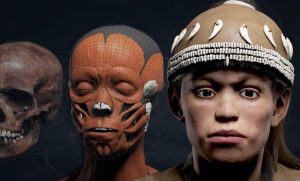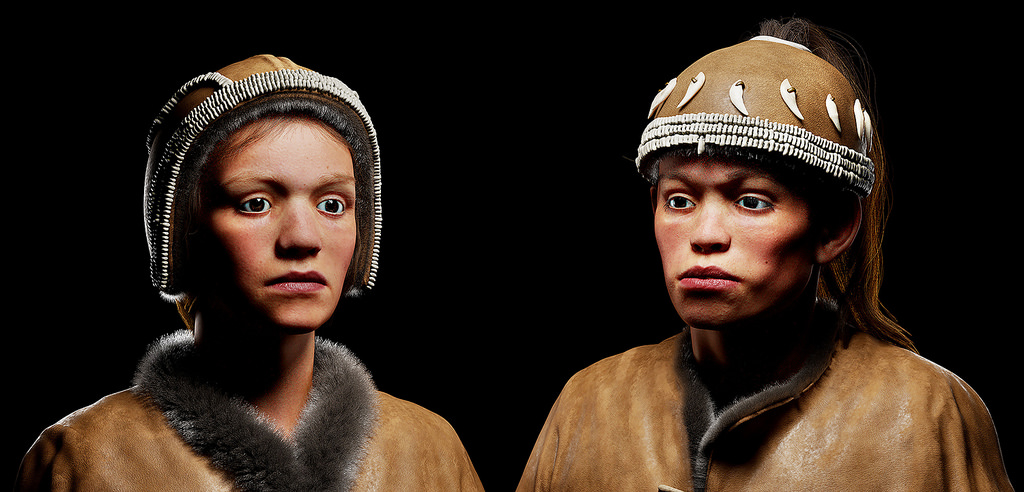
VISUAL SCIENCE—Visual Science and the RAS Institute of Ethnology and Anthropology, with support from the All-Russian Science Festival “Nauka 0+”, have reconstructed the faces of the Sungir people—Homo sapiens who lived 30,000 years ago in Central Russia and are believed to be ancestors of today’s Northern and Eastern Europeans. The new virtual reality 3D animation brings the Sungir people to life. The scientifically accurate visualization is based on skeletal remains from the Sungir site, one of the northernmost Paleolithic settlements in Europe, as well as data from previous efforts to reconstruct the Sungir people’s appearance.
What is Sungir?
- Located in the Vladimir region of central Russia, Sungir is by far the northernmost prehistoric settlement of early modern humans in Europe. It was first excavated by archaeologists in 1956.
- More than 80,000 cultural and household artifacts have been found at the site, which is believed to have been a seasonal hunting camp. Many are made from mammoth bones, Arctic fox canines and stone. Beads, pendants, zoomorphic figurines, engravings and clothing have been among the findings.
- Remains of nine people have been discovered at the site. The best-preserved belonged to two siblings, aged approximately 10 and 13. These were used to create the VR 3D animation.
- Decades of research on the Sungir site have advanced our understanding of human development, migration, and the cultures of Paleolithic Europe.
To create the visualization, two Sungir skulls were laser-scanned and photographed in high definition. The data was then run through state-of-the-art 3D modeling software, where existing data and modern facial reconstruction techniques were applied. The VR animation outlines the steps involved, from marking reference points on the skulls to reconstructing the soft tissues of the head, nose and ear cartilages, to create the final “living” 3D portrait.
The VR animation is based on contemporary research as well as earlier sculptural reconstructions of Sungir people made by Mikhail Gerasimov’s method.
“In the mid-20th century, Soviet archaeologist and anthropologist Mikhail Gerasimov created the first scientifically accurate method for anthropological facial reconstruction based on a person’s skull,” said Sergey Vasilyev, Head of the Department of Physical Anthropology at RAS Institute of Ethnology and Anthropology. “Previously, scientists noted that there is a dependency between the shape of the skull and the elements of appearance. The anatomical and radiographic research methods used by Gerasimov allowed scientists to not only determine standards for the thickness of soft tissues along the face profile line, but also to reveal patterns in the distribution of the soft tissues’ thickness, depending on skull surface morphology development. The structure of particular facial elements was determined by individual morphological features of the skull. Gerasimov’s successors developed techniques to restore the nose and ears. The degree of reconstruction authenticity was determined by a number of facial reconstruction projects that used the skulls of modern people, whose lifetime portraits were available. The methodology was tested mainly on forensic material. The Gerasimov method is still in use in Russia, Europe and the United States. In recent years, reconstruction has become easier due to the introduction of ultrasound scanning and computer tomography.”
“As a scientist, I find this project extremely interesting,”added Viktor Sadovnichiy, rector of Moscow State University and the co-chairman of the All-Russian Science Festival “Nauka 0+. “This is a meeting of multiple scientific disciplines – history, archaeology, cutting- edge computer technology. The result is a work of the highest order, which will find an audience both among the Festival attendees, who will be able to immerse themselves in the world of the Paleolithic, as well as among pedigreed scientists, who will find confirmation of hypotheses that had been put forward earlier”
____________________________________
An illustration of the reconstruction process. VR animation by Visual Science
_________________________________________________
Two individuals, whose remains have been found at Sungir, were reconstructed using the cutting edge techniques. VR animation by Visual Science
___________________________________________________
Museums and schools around the world can access the visualization for free using Android apps compatible with Google Cardboard or any other VR headset at 4K resolution.
“Cutting-edge science combined with computer graphics is a powerful tool for promoting science among children and inspiring young people to learn about history and the natural world. The Sungir site is a global treasure. Special clothing and decorative elements suggest an amazingly high level of cultural development among Homo sapiens living 30,000 years ago. By visualizing these details with scientific rigor, we’re able to share Sungir with the widest possible audience.” — Ivan Konstantinov, CEO of Visual Science.
“I like Sungir VR-animation because the reconstruction was made with high precision and attention to details. The physiognomy of the children, shown in the visualization, recalls Dolni Vestonice 15—remains found at the upper paleolithic site in the Czech Republic” — Professor Jiri Svoboda, Sc.D., Head of Research Centre for Palaeolithics and Paleoanthropology at the Institute of Archaeology of the Czech Academy of Sciences.
________________________________
3D VR facial reconstruction of 30 000 y. o. Homo sapiens from Visual Science on Vimeo.
__________________________________________
Article Source: A Visual Science news release
________________________________
About Visual Science
Visual Science is an award-winning scientific visualization, communication and education studio. Founded in 2007, it develops 3D animations, educational videos, medical illustrations, interactive science apps, and more.
Visual Science has completed hundreds of projects for companies and organizations around the world. They include Nobel Prize laureates, leading scientific publishers (Wiley, Elsevier, Macmillan Publishers, Springer), educational institutions (Cambridge University, Hong Kong University of Science and Technology, Monash University), top-20 pharmaceutical and biotech companies (Johnson & Johnson, Takeda, Novo Nordisk, Roche, Nycomed), advertising agencies, museums, and broadcasting companies.
Since 2010, our projects have attracted millions of views from 148 countries, and have been featured in The New York Times, Los Angeles Times, Nature, PBS, New Scientist, Mashable, National Geographic, Popular Science, Wired, Spiegel and other media outlets.
Visual Science created the first complete, scientifically accurate model of the HIV virus at the atomic level. The company’s 3D models of the HIV and Ebola viruses were awarded “Best Illustration” (2010) and “Honorable Mention – Infographics” (2011) respectively by Science Magazine and the National Science Foundation.
The company has an extensive network of expert consultants, including more than 70 scientists at world-leading research centers across the globe, from Harvard University (USA) to HKUST (Hong Kong).
Article Source: A Visual Science news release
__________________________________________
Receive 30 days free access to the popular new CuriosityStream lineup of documentaries on science, history, nature, and technology as a new Popular Archaeology premium subscriber.
___________________________________________
Travel and learn with Far Horizons.
____________________________________________








